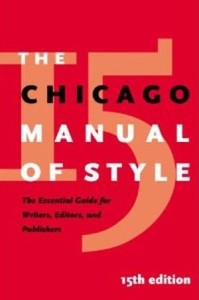If you’re an author writing your first book, you’ve probably heard the terms “stylebook” or The Chicago Manual of Style and wondered what people were talking about. The Chicago Manual of Style is to book editors and publishers what the Bible is to preachers. More about that formidable tome in a moment, but first let’s talk about stylebooks in general.
Stylebooks vs Grammar Books
A stylebook is like a grammar book—full of definitive rules—except the rules it’s talking about don’t have only to do with grammar and punctuation, but also with style. “Style” in this sense doesn’t mean an author’s personal writing style, but rather, the style of a publishing house.
You see, book editors have to make lots of decisions that have nothing to do with grammar and punctuation. We must decide whether to put special terms in quotes (as I chose to do with the terms “style” and “stylebook”) or whether, instead, to write terms in italics (style and stylebook). Both ways are permissible from a grammar/punctuation perspective—it’s a question of style.
Other examples: Is the book editor going to spell out numbers or write them in Arabic numerals? Or spell out small numbers and put large numbers in numerals? Will she write out the word “percent” or use the symbol? Will she spell “catalog” as I just did here or use its variation, “catalogue”? Thousands of such decisions must be made in copy editing a book, and the editor needs to make one choice or the other, then consistently stick with it throughout the manuscript. Consistency is essential.
Where It Gets Tricky
The danger is that around page 87, the editor doesn’t remember if the last time the word “percent” appeared she used the spelled-out version or the symbol. When this happens, she risks writing it the other way, inserting inconsistency into the book and spoiling its professional quality.
 To prevent this sort of confusion, publishing houses create their own stylebooks (also called “style sheets”), in which they write down all of these style decisions. When I accept a book editing job from a publisher, they send me, along with the manuscript, their house style sheet—a list of decisions on how all style questions are to be handled. The decisions have already been made by the publishing house’s senior editors. All the editors who work for that publisher are expected to familiarize themselves with “the house style” and to follow it in their edits.
To prevent this sort of confusion, publishing houses create their own stylebooks (also called “style sheets”), in which they write down all of these style decisions. When I accept a book editing job from a publisher, they send me, along with the manuscript, their house style sheet—a list of decisions on how all style questions are to be handled. The decisions have already been made by the publishing house’s senior editors. All the editors who work for that publisher are expected to familiarize themselves with “the house style” and to follow it in their edits.
But if a publishing house were to write out all its style policies, they would have to write thousands of pages. So most of them use a pre-existing stylebook called The Chicago Manual of Style, and have their editors edit according to that, except for a few variations of their own that they spell out in the house style sheet.
‘The Chicago’
The Chicago Manual of Style is a very large book, in very small print, that contains 956 pages and thousands of style decisions, plus every grammar rule you can imagine (and many more that you can’t). Professional editors have to study it, memorize most of it, and know where to quickly look up any parts they haven’t committed to memory. If you’re an American author preparing your manuscript for publication or submission, you’ll want to hire a professional freelance editor well-versed in the rules of The Chicago Manual of Style.
I say “American author,” because on the other side of the pond, the rules aren’t exactly the same. Most Brits edit according to a different stylebook: The Oxford Manual of Style. And there are other stylebooks widely used as well. For instance, if you were an academic writing a social studies dissertation, you’d want an editor versed in APA style. (APA stands for “American Psychological Association.”) If you were a newspaper editor, you’d edit according to the Associated Press Stylebook.
Get the picture? I might add that if you, the author, are unsure of grammar rules, The Chicago Manual of Style is a book worth consulting. It answers every question you could think of, but it does take some practice learning how to use. If you only have style questions, don’t be overly concerned. Your editor—if she’ a genuine one, trained in the publishing industry—will make sure the final version of your manuscript conforms to all the rules of “the Chicago.”
Ask the Revealing Question
 And that prompts me to add a word of warning . . . when choosing an editor to prep your book for self-publication or submission to an agent or publisher, don’t assume because prospects answer yes to “Do you use The Chicago Manual of Style?” they actually do. Even charlatans posing as online freelance editors know “yes” is the right response to that question.
And that prompts me to add a word of warning . . . when choosing an editor to prep your book for self-publication or submission to an agent or publisher, don’t assume because prospects answer yes to “Do you use The Chicago Manual of Style?” they actually do. Even charlatans posing as online freelance editors know “yes” is the right response to that question.
Instead, when selecting an editor, find out where they worked in the industry and what title they held in their publishing house. If they were a copy editor (a junior editor) or higher, they have had the training, and you can trust them to edit for grammar, punctuation, and style issues. If they were a proofreader, secretary, administrator, or even an acquisitions editor at a book publishing house, they have not been trained in the Chicago. Remember that if they were a newspaper copy editor, they also have not had the training (because newspapers follow different rules and use a completely different stylebook than books use).
Publishing house copy editors are qualified to edit for grammar and punctuation and to make style decisions. What copy editors are not trained in is developmental editing, sometimes called “substantive editing.” If you want your book reviewed for content—macroscopic issues, such as structure, consistency, organization, flow, tone, clarity, voice, and redundancy (in fiction it would be all of the above plus plot development, tension, pacing, dialog, character arc, description, point of view, setups and payoffs), then you are in need of a full-scale, senior editor—a developmental editor. Developmental editors supervise and train copy editors. Only they have the requisite skills to offer reliable advice on the content issues of your book.
Jessi Rita Hoffman … book editing by an industry professional
